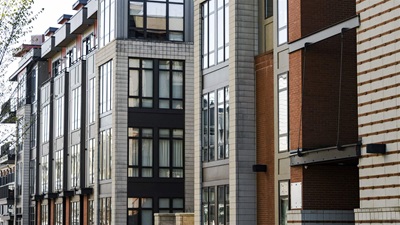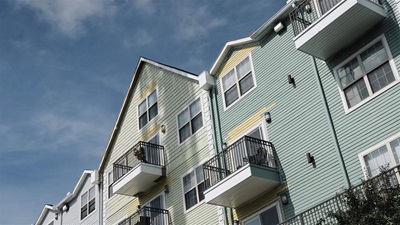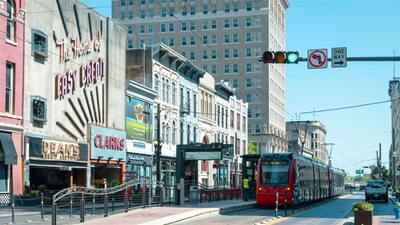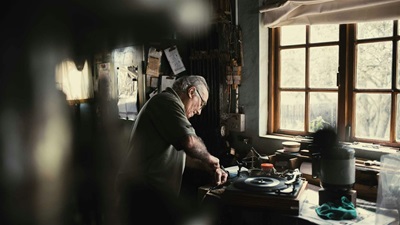States Advance Single-Stairway Reforms to Expand Housing
New laws in Colorado, Montana, New Hampshire, and Texas modernize building codes to improve housing supply, affordability

Lawmakers across the United States are turning to a relatively simple but potentially effective reform to ease the nation’s housing shortage: Allow small and medium-sized apartment buildings to have a single stairway rather than two, as is required in most of the country. Until recently, Seattle and New York City were the only U.S. cities to allow four-to-six-story apartment buildings with only one stairway—even though they are legal in much of the world. This move to reform building codes is part of broader bipartisan efforts to increase housing supply and improve affordability.
Allowing the construction of single-stairway buildings enables the development of much-needed multifamily housing, particularly in cities where vacant land is scarce and expensive. Single-stairway designs aren’t as expensive to develop as similar dual-stairway buildings, costing 6% to 13% less to construct. They also can fit in small, vacant, or irregular infill lots, which are often located along commercial corridors or near transit and are too small for dual-stairway buildings to be economically viable.
Record number of states move to modernize building codes
Since 2022, 19 states and Washington, D.C., have introduced bills to study or allow the construction of single-stairway buildings, with limits on both height and building size. In 2025 alone, seven states have passed and signed bipartisan legislation on single-stairway apartment buildings: Colorado, Montana, New Hampshire, and Texas now allow them; Maine is in the process of doing so; Hawaii and Maryland will convene groups to study this reform.
The states have taken somewhat different approaches. Montana and Texas will allow apartment buildings up to six stories (with limits on square footage), compared with five stories in Colorado and four in New Hampshire. Each state’s law expands the potential for new midrise apartment buildings. Montana’s law is the strongest because it applies to all jurisdictions and provides for the greatest possible number of units in a single-stair building, with fewer additional restrictions than other states.
After a state enacts legislation to allow single-stairway buildings, jurisdictions that have their own building codes must generally adopt such reforms. Single-stairway apartment buildings have proved to be popular with local legislators as well. After Tennessee passed legislation allowing single-stair apartment buildings in 2024, the state’s four most populous cities—Chattanooga, Knoxville, Memphis, and Nashville—adopted building code reform. So did the regional center of Jackson.
One co-sponsor of Colorado’s single-stair legislation, Speaker Pro Tempore Andrew Boesenecker, said: “This smart stair policy is safe and will help us create more housing Coloradans can afford. Firefighting technology and fire protection techniques have significantly improved in the last few decades, and it’s time that we modernize our building codes to account for these safety improvements and reduce the cost of building multifamily housing.”
Montana Senator Daniel Zolnikov, sponsor of a one-stairway bill that took effect Oct. 1, told researchers from The Pew Charitable Trusts: “Single-stair apartment buildings are safe, cost-effective, and reduce the size of the complex. States across the country passed this legislation with overwhelming support because it was common sense.”
While allowing the construction of single-stairway apartment buildings has gained traction with lawmakers in different regions of the country and across party lines, research shows that there is also public support for allowing more apartment buildings in general, especially near jobs and commerce. City officials have taken notice, and single-stair legislation has been part of the solution, with Austin, Texas, adopting legislation to allow single-stair construction earlier this year; a bill advancing in Los Angeles; and bills introduced in Baltimore, Chicago, Washington, D.C., and other cities.
Modern apartment buildings are the safest type of housing in the U.S.
Recent research from Pew shows that modern four-to-six story single-stairway buildings are as safe as other types of housing. Where they have been allowed—including, for example, in New York City—the rate of death from fire has been no higher than in other types of buildings. Single-stairway apartment buildings have all the modern safety features found in other new apartment buildings, such as sprinklers, enclosed stairways, self-closing doors, and fire-rated walls.
First-of-its-kind research from Pew also shows that modern apartment buildings (built since 2000) are much safer than the 93% of American homes that are not modern multifamily housing. New single-stair buildings would be built with the same types of modern technologies and standards that have improved multifamily fire safety. This suggests that allowing single-stair buildings would improve not only housing supply but also fire safety.
Revising outdated building codes will not completely resolve the nation’s housing shortage. But it could be one part of the solution.
Chase Hatchett is a principal associate with The Pew Charitable Trusts’ housing policy initiative.












